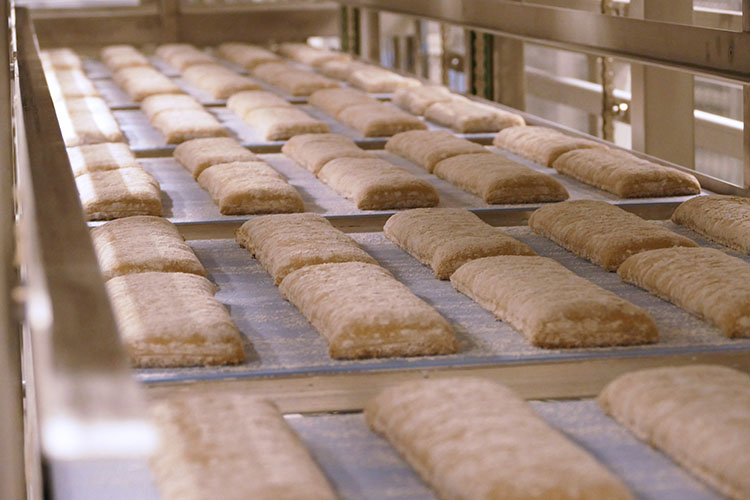
Bread consumption is once again on the rise, with the market expected to grow annually by 6.80% and reach
a worldwide volume of 216.70 bn kg by 2028. The technology to support efficient, automated production of high-end, quality bread is here. The key is gentle dough handling.
Per capita, bread consumption should be over 24 kg this year, and it is poised for steady growth. Among the categories that entice consumers, artisan-style breads, premium ranges and perennial favorites such as baguettes are popular choices.
Royal KAAK: Baking freestanding bread
The Dutch ‘silo to truck’ solutions manufacturer develops production lines for all kinds of freestanding bread, with a capacity of around 7,500 kg/h, depending on the production process, type of end products and available space. Recently, lines with production volumes ranging from 2,500 to 5,000 kg/h have been frequently requested.
Rolls and boules can be made, from 80 g to 1,000 g, as well as crystal buns with an open structure. Molded products such as (demi-) baguettes and loaves can also be produced with this line, as well as pointed baguettes. When a sheeting line is utilized, ‘die-cut’ products are also an option, with several shapes (e.g.: triangle cut, angled cut, omega cut, hexagonal cut, or octagon cut). The line is not just limited to bread: it can also be used to manufacture pinsa, which, in some cases, should be proofed on peelboards.
The line replicates all the traditional process steps of when the dough was kneaded by hand, proofed in baskets and baked in a stone oven. Delicate operations when forming and handling the dough are key.
KAAK offers bulk fermentation solutions for this line, which support the quality of the end products and help reduce the additives needed.
”A focus point while using peelboards is the correct use of the release agents and flour on peelboards in combination with the type of dough processed. We always carry out internal project tests to optimize it.”
Royal KAAK specialists
Dough processing and the end products are the central points of a freestanding bread production line designed by KAAK, explains Rens van Heesch, Product Sales Manager, DrieM sheeting lines. This means that the utmost care is given to the gentle handling of the dough, during the volumetric dividing process, or as it goes through dough sheet reduction. Either dough makeup systems can be used (lining up a divider, rounder, proofer and molder), or a sheeting line that is designed especially for bread processing. The standard line configuration features a sheeting line that is suitable to handle highly-hydrated doughs with long fermentation times. The operating principle is that the dough is gently reduced with the help of two multi-rollers.

Bread on peelboards and directly on belts
Highly hydrated doughs are placed on peelboards for processing. Once the dough is deposited on the peelboards, the dough pieces are placed in the KAAK final proofer.
After decoration, they are ready for the oven, where a machine ‘peels’ the products from the peelboards and places them on the oven belt. The line cleans the peelboard again and transports it to the start where new dough pieces are prepared for production.
“A focus point while using peelboards is the correct use of the release agents and flour on peelboards in combination with the type of dough processed. We always carry out internal project tests to optimize it,” KAAK highlights.
Even after the dough make-up phase, gentle handling is the main priority for the next process steps; for example, the pieces are carefully removed from peelboards and placed on the oven belt.
For dough dividing, the Dough Master was the equipment selected to be a part of this line. Nigel Morris, global head of technology at KAAK explains why: “This divider guarantees better control of the dough because it is completely servo-driven.” The company recently delivered two freestanding bread lines for rounded and oval molded loaves equipped with this divider.
Many other options are possible to meet the individual needs of the customer, for example top and bottom decoration of the dough piece as well as decoration by guillotine stamping.

New features
KAAK has recently brought new features to the freestanding bread line, making it more flexible and hygienic. “We introduced several new innovations: the robot scoring system is vision-based, which ensures a high degree of accuracy and flexibility in scoring patterns. It is perfectly suitable for multi-product, freestanding bread lines,” KAAK highlights. Different types of cutting tools can be used, depending on the type of dough being processed and the desired cutting pattern.
The rounding unit of the DrieM sheeting line has also been recently upgraded and can now handle 5,350 pieces of dough of up to 850 g. In addition, the soft dough sheeting section has been revised and now provides better access for cleaning, to meet increasing hygiene requirements from the industry and based on the specialists’ field experience. Process consistency
The line closely controls the process to maintain it under the optimum parameters. For example, standard solutions integrate check weighing into the dough make-up lines. The mixing process is monitored, with temperature sensors that can be placed in several hoppers. This ensures mixing consistency at all times. All temperature and, in some cases, humidity settings for proofing, baking, cooling and freezing are checked and automatically adjusted. The PLC data can be connected with existing MES systems, to share information related to production to the overall data management system. “On request, we also offer the possibility of integrating constant monitoring of the motor amperages,” KAAK specialists explain.
In addition, detection points have been integrated into the sheeting line to automatically control the process. As a result, fewer interventions will be needed from the single operator, required to run the line.
The article is part of an extended feature, which was originally published in [BBI 4 – 2023]. Read the full article in the magazine:


